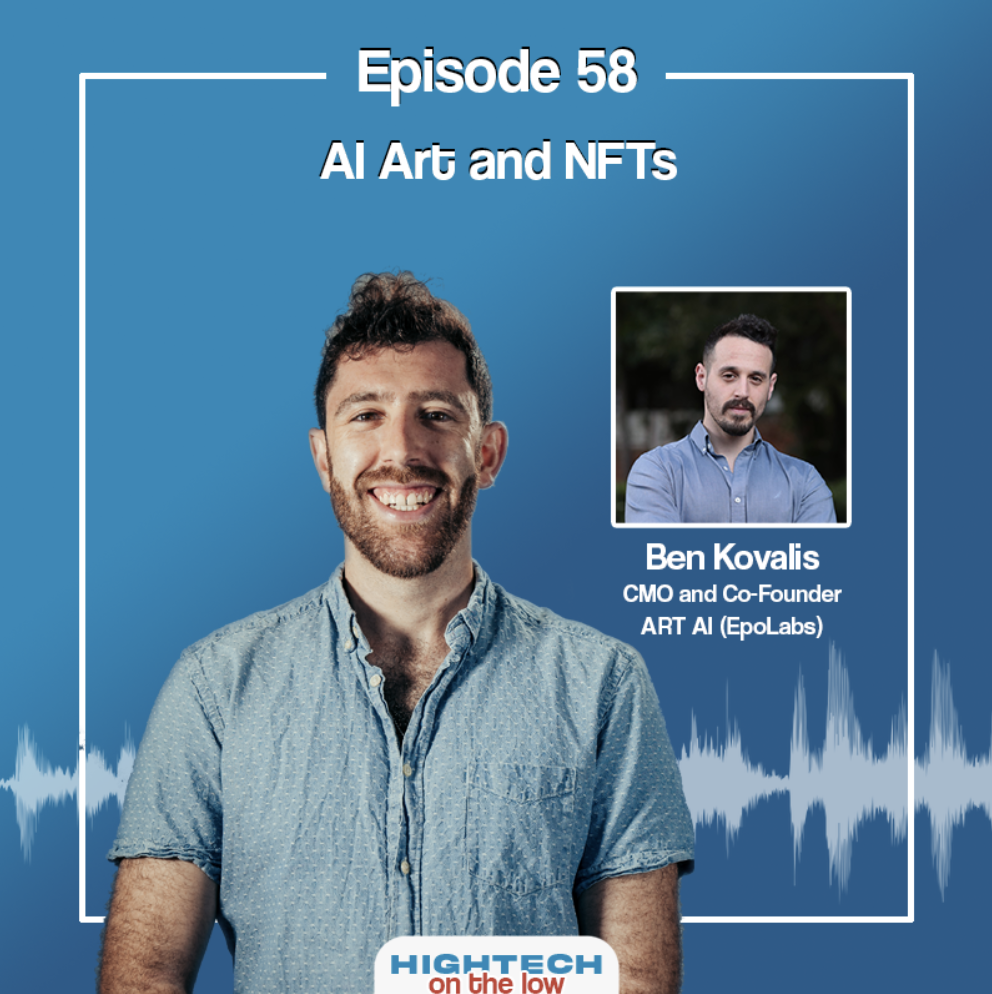We cover the israeli hi-tech and startup scene so that you can read about it.
Web 3.0 is growing and it’s people like Ben Kovalis, co-founder and CMO of EpoLabs by Art AI, who are at the forefront. We talk about what AI-generated art is, how it became a success overnight, and what it means for the world of NFTs, marketing, and art as we know it.
High Tech on the Low hosted by Jordan Kastrinsky, is on a mission to make high tech accessible to the world. In my podcast, I explore the many different facets of the world of high tech from development to marketing, to sales, to entrepreneurship and more! With society turning ever more towards technological solutions to make processes more efficient and secure, it is important, now more than ever, that we unite the high-tech sector’s collective resources under one roof to reap the benefits of this knowledge-sharing. There is so much opportunity out there to grow within the industry that we must provide the tools through which to do so.
Sure, you probably have heard about NFTs – the weird, bored monkeys or some crypto hoodlums that are just some of the projects gracing the nascent NFT world. For those unfamiliar with NFTs, here’s a brief recap: NFTs are non-fungible tokens which act as financial security often represented through digital artwork that stores digital proprietary data using blockchain technology.
Ownership of an NFT is validated on the blockchain, facilitating easy transactions between buyers, traders, and sellers. What makes them useful is that they are unique, there are no two NFTs that are the same. Anyone can create an NFT, upload them to various marketplaces, and initiate transactions with them. Often NFTs contain more than just digital data and art, but actual digital files such as photos, videos, audio, or even smart contracts that dictate certain rules, benefits, or promotions associated with the NFT.
However, Ben Kovalis, co-founder and CMO of EpoLabs by Art AI, did not originally consider the NFT space when he joined his partner Eyal. “The premise of the project was to build a machine to make an infinite number of art pieces using artificial intelligence,” says Ben. Yet, Ben understood that a key element of art lies in its scarcity, the fact that it cannot necessarily be mass-produced. “So, the whole idea became to sell an infinite number of UNIQUE pieces online” and since NFTs offer that uniqueness Ben needed for his project to succeed, he and his co-founder decided to go down that route.
But is AI-generated art making art seem inauthentic? According to Ben, initially, educating the market about AI-made art pieces was challenging as not many people knew such technology existed. By introducing such a novel technology, Ben suggests that they, along with their early adopters, were opening people’s horizons to explore new perspectives of art and slowly accept AI art pieces. Even today, it can be hard to identify what art is created by a human or a computer, and, while people may have their own opinions, love it, or hate it, AI art can be a great conversation starter. “It’s not the easiest thing to explain to people,” Ben adds, “but at the end of the day if you don’t know it’s AI, then how would you know it’s not human-made?”
After eventually being exposed to NFTs, and with some careful analysis of the market, around a year ago, Ben and his co-founder decided to enter the space. They created a new interface allowing “anyone to create their own art piece using text, any text, a section from your favourite book, sentences, whatever, and you would get an AI-generated image based on the text you wrote,” as Ben puts it. The team was essentially democratizing access to artistic ability, which if we are being honest, many people lack. The Art AI interface allows anyone to make any art piece with any words they want, no skills attached.
To keep their original collection, Eponym, scarce, they limited the NFT amount to 10,000 pieces and once a word was used and the NFT minted, then no one else could use it. Moreover, the word and its owner were verified on the blockchain, making the whole process secure and trustworthy. “So, you can have only one ‘Elon Musk’, you could have ‘Elon Musk with a crown’, but only one ‘Elon Musk’,” remarks Ben. The project was a hit in the NFT space and within a few short hours, users had minted the entire quota, an incredible feat for the two founders.
So, what does the future hold for Ben and Art AI? With their success, they have gone on to build even more collections and are leveraging partnerships with major artists and other NFTs projects. At the same time, they are still working on their unique interface and developing it further to test new use cases for their AI-art generation machine.
Ben is also hopeful that as more people grow in familiarity with NFTs the more the space will open up and more people will begin using Art AI. “In the meta space you can take pride in being early, this is an amazing opportunity that is not going to repeat itself, so if you have a good idea to be innovative then go for it!”
Get the latest posts delivered right to your inbox
Co-Managing Partner JB Upscale, Host of High Tech on the Low, Community Manager at Front Team, Content Creator, Tech Enthusiast
Co-Managing Partner JB Upscale, Host of High Tech on the Low, Community Manager at Front Team, Content Creator, Tech Enthusiast
Stay up to date! Get all the latest & greatest posts delivered straight to your inbox

